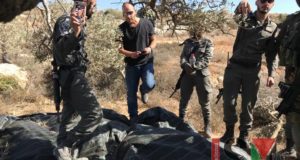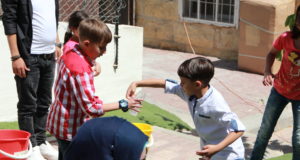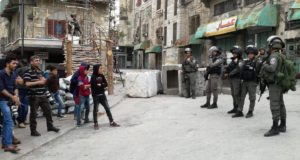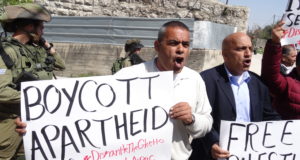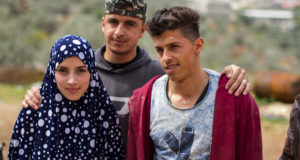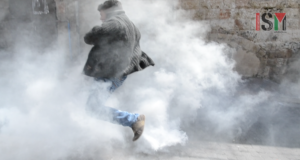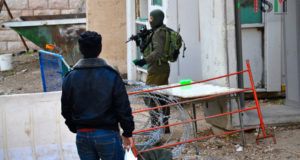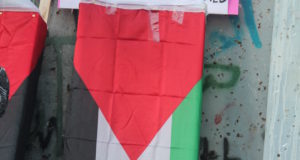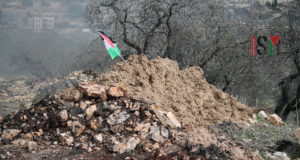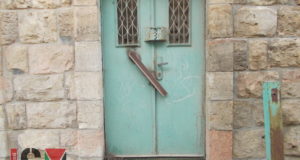31st October 2017 | International Solidarity Movement, Nablus team | Nablus, Occupied Palestine On Sunday the 29th of October 2017 – near the Palestinian village As Sawiya – Palestinians and Internationals harvesting olives were met by the Israeli army. Three ...
Read More »Eid celebration for children in Tel Rumeida, occupied Hebron
29th June 2017 | International Solidarity Movement, al-Khalil team | Hebron, occupied Palestine On Tuesday the founders of the Tel Rumeida Garden next to the Gilbert checkpoint in occupied al-Khalil (Hebron) organised an Eid celebration for the children from the ...
Read More »In Pictures: al-Khalil on lockdown as Israeli settlers and tourists celebrate Pesach
14th April 2017 | International Solidarity Movement, al-Khalil team | al-Khalil (Hebron), occupied Palestine Since the evening of April 10th, 2017, Israeli forces have imposed increased restrictions on the Palestinians of al-Khalil as colonial settlers and Israeli tourists celebrate Pesach ...
Read More »Dozens protest against AIPAC in Hebron sunshine
26th March 2017 | International Solidarity Movement, al-Khalil team | Hebron, occupied Palestine Dozens of Palestinians gathered in Tel Rumeida, al Khalil, to protest against the annual AIPAC (American Israel Public Affairs Committee) conference held in Washington, DC. Lacking the freedom of ...
Read More »Political Prisoners absent during Palestinian Mother’s Day
23rd March 2017 | International Solidarity Movement, Ramallah Team | Kafr ad-Dik, Occupied Palestine On 21st of March, Palestine celebrated their Mother’s Day. A group of Palestinian and international activists visited the village of Kafr ad Dik in the Salfit ...
Read More »Hebron’s eighth annual demonstration to open Shuhada Street: in pictures
2nd March 2017 | International Solidarity Movement, al-Khalil team | Hebron, occupied Palestine The eighth annual demonstration against the closure of the Tel Rumeida and Shuhada Street districts of Hebron was dispersed by Israeli violence within five minutes of setting ...
Read More »Photo story: Gilbert checkpoint impeding Palestinian daily life (January 2017)
31st January 2017 | International Solidarity Movement, al-Khalil team | Hebron, occupied Palestine In the old city of occupied al-Khalil (Hebron), Palestinians’ freedom of movement is impeded by a large number of Israeli checkpoints. In the Tel Rumeida neighborhood, many ...
Read More »Demonstrators demand return of martyrs bodies in Bethlehem
15th January 2017 | International Solidarity Movement, al-Khalil team | Bethlehem, occupied Palestine The Prisoners Club held a demonstration and march to the illegal apartheid wall on Sunday afternoon to demand the return of the bodies of martyrs held unjustly ...
Read More »Villagers continue to resist settlements in Kafr Qaddum
13th January 2017 | International Solidarity Movement, al-Khalil Team | Kafr Qaddum, Occupied Palestine The Friday demonstration against the illegal wall in Kafr Qaddum was attended by over 100 Palestinians along with numerous pro-Palestinian Israelis and other internationals. Two days ...
Read More »Photo-Story: Mini walking tour of occupied Hebron
24th November 2016 | International Solidarity Movement, al-Khalil team | Hebron, occupied Palestine After our afternoon school run today, two of us took a walk around a small part of Al Khalil. The photos are sort of a mini-walking tour ...
Read More » International Solidarity Movement Nonviolence. Justice. Freedom.
International Solidarity Movement Nonviolence. Justice. Freedom.
